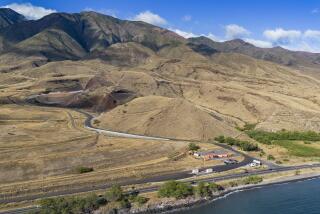Cleanup of Times Beach May Be Ready to Begin
TIMES BEACH, Mo. — Times Beach has been a boarded-up ghost town since the federal government bought up all 801 homes and businesses seven years ago and moved the people out after the discovery of dioxin in the soil.
Now, the government is finally close to building a huge incinerator to clean up the highly toxic compound and heal the deserted town, a grim reminder to former residents of lives turned upside down by their evacuation.
The U.S. Environmental Protection Agency plans to burn all of the soil that was contaminated in the 1970s by dioxin-tainted oil sprayed on unpaved streets to keep the dust down. The agency also wants to treat contaminated soil from other sites in eastern Missouri, leaving it almost 100% clean.
It says the incinerator would be dismantled afterward, but a vocal contingent of neighbors who fear for their safety is trying to block the incinerator, which they say will become a permanent fixture. “It’s spooky,” said Eureka Mayor Otis Nelson. “How would you like to live next to it? How would you like to encourage development next to it?”
Nelson is so concerned that he is advocating that his town annex the neighboring wasteland of Times Beach to gain some leverage about what happens there, even though it would mean increased liability.
“We have no choice but to take that risk,” Nelson said.
Former residents of the community, about 20 miles southwest of St. Louis, just want the cleanup to begin, which all sides agree is long overdue.
“If this cleanup doesn’t take place, I’m afraid Times Beach is still going to be sitting there like it is today, five to 10 years down the road,” said Marilyn Leistner, a former mayor. “It’s been eight years. Something needs to be done.”
Dioxin, an unwanted byproduct in the manufacture of other chemicals, is suspected of causing disorders of the nervous system, liver, kidneys and bladder in humans. It has been linked to cancer in laboratory animals also.
Beth-ann Eichenser, an EPA spokeswoman, said the incinerator plans are too far along to be threatened by last-minute opposition from Nelson’s Times Beach Environmental Task Force.
Nelson said his group opposed the incinerator, to be built alongside the Meramec River, because it would be vulnerable to flooding and because of fears that the EPA might not dismantle it, thus making Times Beach the nation’s dioxin dump.
“We feel that once this incinerator gets here, it’ll never leave. There’s no doubt in my mind that it’d be permanent,” Nelson said. “Maybe they do need a permanent incinerator. But is St. Louis County the place to put it? This makes no sense.”
Nelson said he has received support from other municipalities and residents. Bills have been introduced in the Legislature to prohibit the building of an incinerator in a flood plain and within 5 miles of a school.
Nelson’s group wants the EPA to either bury the soil in a permanent container or use a commercial incinerator that already exists in Sauget, Ill., across the Mississippi River from St. Louis.
Eichenser said work can begin as early as summer on the $118-million cleanup, which could take 10 years.
“I know that there are many residents in Eureka who say: ‘Well, it’s in our back yard.’ But Times Beach is 400 acres of unpopulated land. It’s a viable, obvious location to do this project,” Eichenser said.
“People view incinerators like Chernobyl,” she said. “They think it’s going to blow up and dirt will fly everywhere. This would be safe.”
The EPA said the so-called thermal treatment unit would “roast” the contaminated dirt, breaking the dioxin molecules into carbon, oxygen, chlorine and hydrogen. Eichenser said the treated soil would be 99.999% clean and could be turned back into regular soil.
Eichenser said the incinerator, which would process soil from Times Beach and up to 27 other eastern Missouri sites, would be surrounded by a levee to protect it from floodwaters.
Flooding is a big part of Times Beach, which sprung up in the 1900s as a weekend retreat for St. Louis residents.
The worst flood came at the end of 1982. Rain had fallen for days, but many residents were caught by surprise and forced to flee when the Meramec spilled over its banks, reaching the second floor of homes.
Many residents never returned. Days later, the Centers for Disease Control and the Missouri Division of Health announced the dioxin findings and recommended that the town be evacuated.
The town officially ceased to exist when Times Beach’s alderman voted to disincorporate in 1985.
More to Read
Sign up for Essential California
The most important California stories and recommendations in your inbox every morning.
You may occasionally receive promotional content from the Los Angeles Times.










